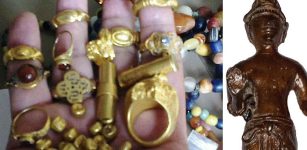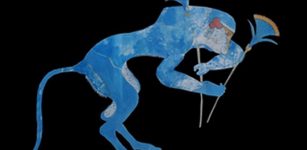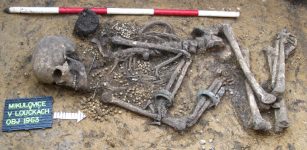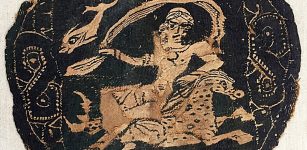“Thogcha” – Thousand-Year-Old Tibetan Amulets And The Bon Culture
A. Sutherland - AncientPages.com - Enigmatic small amulets known as' thokchas' (thogchags) are made of iron, meteoric iron, or, as Tibetans say, "sky metal" or "sky-iron" denote tektites and meteorites, which are often high in iron content.
Tibetan thokcha, showing crouching lion in centre. Credit: Clemensmarabu - CC BY-SA 3.0
"Thogcha," heavenly iron or sky iron, has been used by Tibetans for thousands of years to create small talismans with a strong connection to the sky. Their tradition is much older than the Buddhistic tradition in Tibet and has its beginning in the pre-Buddhist period of Tibet.
Historically, thokchas were highly respected objects and used for sacred metallurgical fabrication of weapons, musical instruments, and sacred (religious) tools, like - the phurba, a three-sided peg, stake, knife, or nail-like ritual implement traditionally associated with Indo-Tibetan Buddhism, Bon (Bön), a Tibetan religion and Indian Vedic traditions.
The use of 'thogcha' in the metallurgical fabrication of sacred objects cast of Panchaloha is well-documented. The term has also denoted ancient metal objects as amulets made from thokcha. They are traditionally endowed with magic and protective power and are comparable to Tibetan Dzi beads.
Tibetan thokcha in the shape of a small arch. It may originally have been a tool used to open knots in leather straps that secured pack animal loads. Credit: Clemensmarabu - CC BY-SA 3.0
It was when the so-called Bon religion and culture with its heavenly origin dominated.
Even today, many rituals to attract luck and good fortune and chase away evil forces are conducted regularly because the power of tradition and human beliefs has always prevailed.
Bon's indigenous religion and culture were long-time dominant religious forces in the plateau. Though considerably transformed by Buddism, the Bon has survived and is still preserved among Tibetan communities living in exile.
Many ancient Tibetan scriptures supported by archeological evidence refer to the Bon culture and its roots spanning 18,000 years.
As John V. Bellezza, an explorer, a writer, and the foremost archaeology specialist in the cultural history of Tibet said that there is "... a close association with indigenous Tibetan religious beliefs and their practitioners and form a very important part of the country's pre-Buddhist and Buddhist heritage. For instance, the frequency of animal designs recalls the sacred status of animals in Tibetan culture..."
 Meteorite DZI bead "9 eyes" carved from Aletai iron meteorite. Image credit: IPlantagenet - CC BY-SA 4.0
Meteorite DZI bead "9 eyes" carved from Aletai iron meteorite. Image credit: IPlantagenet - CC BY-SA 4.0
Believed to be magically formed, powerful thogchags belong to the most treasured possessions of the Tibetans. As they say, if you own one, you are happy, but the Gods bless you if you own nine of them!
They are most often worn around the neck on a blessed cord. Sometimes they used to be attached to a mala used for spiritual practice, a prayer wheel, or objects frequently used by Tibetan magicians, healers, and shamans, in rituals performed by them.
Sacred "thogchags" represent a variety of shapes and forms, from simple depictions of animals, and tiers symbolizing the five elements (space, air, fire, water, and earth). These elements compose the universe
The most ancient depictions on the small miniatures are beyond the comprehension of modern-day Tibetans, who do not understand their true meaning. In this way, they remain the concealed mystery of the ancients.
Priceless "thogchags" are considered to have great medicinal value and almost supernatural quality. Due to their mystical healing properties, they are true treasures. Families in Tibet pass down these sky relics from one generation to another.
No one has ever questioned their value and importance.
Written by – A. Sutherland - AncientPages.com Senior Staff Writer
Updated on August 18, 2022
Copyright © AncientPages.com All rights reserved. This material may not be published, broadcast, rewritten or redistributed in whole or part without the express written permission of AncientPages.com
More From Ancient Pages
-
 Prehistoric Spread Of Millet From East Asia To Central Europe – New Study
Archaeology | Jun 10, 2022
Prehistoric Spread Of Millet From East Asia To Central Europe – New Study
Archaeology | Jun 10, 2022 -
 Amage: Sarmatian Warrior Queen/Regent Who Impressed With Remarkable Military Skills
Featured Stories | May 23, 2023
Amage: Sarmatian Warrior Queen/Regent Who Impressed With Remarkable Military Skills
Featured Stories | May 23, 2023 -
 The Bushido Code: Centuries-Old Unwritten Code For Ideal Samurai Warrior
Featured Stories | Dec 26, 2016
The Bushido Code: Centuries-Old Unwritten Code For Ideal Samurai Warrior
Featured Stories | Dec 26, 2016 -
 On This Day In History: Ueshiba Morihei, The ‘Founder of Aikido’ Was Born – On Dec 14, 1883
News | Dec 14, 2016
On This Day In History: Ueshiba Morihei, The ‘Founder of Aikido’ Was Born – On Dec 14, 1883
News | Dec 14, 2016 -
 Legendary Lost Island Of Gold Of The Mysteriously Vanished Srivijaya Civilization Found Underwater
Archaeology | Oct 25, 2021
Legendary Lost Island Of Gold Of The Mysteriously Vanished Srivijaya Civilization Found Underwater
Archaeology | Oct 25, 2021 -
 Another Franklin Expedition Crew Member Identified
Archaeology | Sep 26, 2024
Another Franklin Expedition Crew Member Identified
Archaeology | Sep 26, 2024 -
 Gargoyles – Mysterious Ancient Fearsome Creatures Warding Off Evil
Featured Stories | Nov 25, 2024
Gargoyles – Mysterious Ancient Fearsome Creatures Warding Off Evil
Featured Stories | Nov 25, 2024 -
 Neanderthal Cave Engravings Identified As Oldest Known, More Than 57,000 Years Old
Archaeology | Jun 22, 2023
Neanderthal Cave Engravings Identified As Oldest Known, More Than 57,000 Years Old
Archaeology | Jun 22, 2023 -
 Sacred Hidden Buyan Island And The Mysterious Alatyr Stone With Healing Powers May Have Existed
Featured Stories | Mar 22, 2018
Sacred Hidden Buyan Island And The Mysterious Alatyr Stone With Healing Powers May Have Existed
Featured Stories | Mar 22, 2018 -
 Mystery Of The Minoan Blue Monkeys Depicted In Frescoes
Archaeology | Apr 16, 2020
Mystery Of The Minoan Blue Monkeys Depicted In Frescoes
Archaeology | Apr 16, 2020 -
 Central European Prehistory Was Highly Dynamic – New Study Shows
Archaeology | Aug 27, 2021
Central European Prehistory Was Highly Dynamic – New Study Shows
Archaeology | Aug 27, 2021 -
 Surprising Mask Of A Human Face Found On Cistern Wall In The Ancient City Of Ptolemais
Archaeology | Jan 17, 2025
Surprising Mask Of A Human Face Found On Cistern Wall In The Ancient City Of Ptolemais
Archaeology | Jan 17, 2025 -
 Vikings Had Dark Humor And Joked Even During Deadly Battles
Vikings | Aug 20, 2024
Vikings Had Dark Humor And Joked Even During Deadly Battles
Vikings | Aug 20, 2024 -
 85 Beautiful And Rare Coptic Textiles – A Gift To Museum At Queens College
Archaeology | Apr 4, 2017
85 Beautiful And Rare Coptic Textiles – A Gift To Museum At Queens College
Archaeology | Apr 4, 2017 -
 Incredibly Well-Preserved Viking Age Ski Discovered Under Melting Ice
Archaeology | Nov 8, 2022
Incredibly Well-Preserved Viking Age Ski Discovered Under Melting Ice
Archaeology | Nov 8, 2022 -
 Unknown Purpose Of The Mysterious Huge Iron Age Ceramic Sharjah Jar Puzzles Scientists
Archaeology | Oct 7, 2022
Unknown Purpose Of The Mysterious Huge Iron Age Ceramic Sharjah Jar Puzzles Scientists
Archaeology | Oct 7, 2022 -
 Castro People: Intriguing Life Of The Female-Dominated Society In Ancient Iberia
Featured Stories | Oct 23, 2024
Castro People: Intriguing Life Of The Female-Dominated Society In Ancient Iberia
Featured Stories | Oct 23, 2024 -
 On This Day In History: Tycho Brahe 1st Sketches “Tychonic System” Of Solar System – On Feb 13, 1578
News | Feb 13, 2017
On This Day In History: Tycho Brahe 1st Sketches “Tychonic System” Of Solar System – On Feb 13, 1578
News | Feb 13, 2017 -
 One-Eyed Giant Polyphemus – Most Famous Of The Cyclops In Greek Mythology
Featured Stories | Jan 25, 2018
One-Eyed Giant Polyphemus – Most Famous Of The Cyclops In Greek Mythology
Featured Stories | Jan 25, 2018 -
 48,000-Year-Old Tooth That Belonged To Neanderthal Child Found In Northern Italy
Fossils | Sep 19, 2020
48,000-Year-Old Tooth That Belonged To Neanderthal Child Found In Northern Italy
Fossils | Sep 19, 2020


